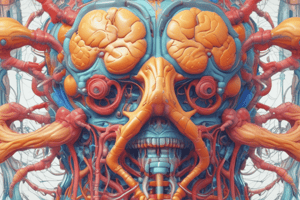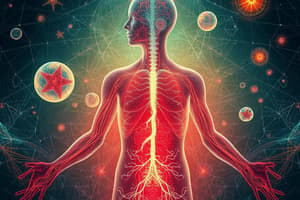Podcast
Questions and Answers
Which component of the homeostasis control system is responsible for processing the information received from environmental changes?
Which component of the homeostasis control system is responsible for processing the information received from environmental changes?
- Receptor
- Control center (correct)
- Regulator
- Effector
What is the effect of a positive feedback mechanism on the response to a stimulus?
What is the effect of a positive feedback mechanism on the response to a stimulus?
- It stabilizes the system.
- It amplifies the response to the stimulus. (correct)
- It maintains homeostasis.
- It decreases the effect of the stimulus.
Which intravenous solution would you consider hypotonic after glucose metabolism?
Which intravenous solution would you consider hypotonic after glucose metabolism?
- 0.9% Saline
- 5% Dextrose in 0.9% Saline
- Lactated Ringer's Solution
- D5W (5% Dextrose in Water) (correct)
Which of the following cations is predominantly found in extracellular fluid?
Which of the following cations is predominantly found in extracellular fluid?
Osmolarity is defined as the concentration of solutes per liter of which component?
Osmolarity is defined as the concentration of solutes per liter of which component?
Flashcards are hidden until you start studying
Study Notes
Homeostasis Control System
- Receptor detects changes in the environment.
- Control center processes information from the receptor and sends instructions to the effector.
- Effector carries out the response to restore balance.
Feedback Mechanisms
- Negative feedback reduces the original stimulus and brings the system back to its set point.
- Positive feedback amplifies the original stimulus and moves the system further from its set point.
Body Fluid Compartments
- Extracellular fluid (ECF) includes interstitial fluid and blood plasma.
- Intracellular fluid (ICF) is found inside cells.
Osmolarity and Tonicity
- Osmolarity is a measure of solute concentration per liter of solution.
- Tonicity describes how a solution affects cell volume.
- Hypotonic solutions have a lower solute concentration than the cell, causing water to move into the cell and the cell to swell.
- Hypertonic solutions have a higher solute concentration than the cell, causing water to move out of the cell and the cell to shrink.
- Isotonic solutions have the same solute concentration as the cell, resulting in no net water movement.
Body Fluid Electrolytes
- Sodium (Na+) is the primary cation in extracellular fluid, crucial for fluid balance and nerve function.
Studying That Suits You
Use AI to generate personalized quizzes and flashcards to suit your learning preferences.




